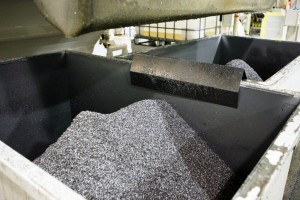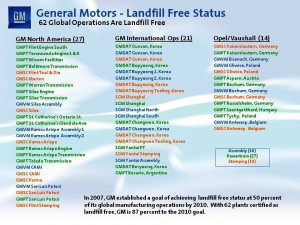
Materials recycled this year include 650,000 tons of metal, 16,600 tons of wood, 21,600 tons of cardboard, and 3,600 tons of plastic.
Sixty-two General Motors Company manufacturing plants have achieved “zero landfill” status by recycling or reusing all normal plant wastes, the Detroit based automaker said today. This means 43% of its global manufacturing facilities no longer send any production waste to landfills.
GM’s goal, announced in 2008, is to convert half of its major manufacturing facilities worldwide into landfill free operations by the end of 2010. To date, GM is now close to delivering on that commitment.
“We’ve been working for quite some time at eliminating waste and developing support systems to recycle or reuse wastes we can’t yet eliminate,” said Mike Robinson, GM vice president of Environment, Energy and Safety policy. “These plants have taken this process to its highest level. They are leading General Motors and the worldwide manufacturing industry.”
Landfill-free GM plants include 27 facilities in North America, 21 facilities in Asia-Pacific and Latin America, and 14 facilities in Europe.
On average, more than 97% of waste materials from GM’s zero landfill plants are recycled or reused and about 3% is converted to energy at waste-to-energy facilities replacing fossil fuels. More than 2 million tons of waste materials will be recycled or reused at GM plants worldwide this year. An additional 45,000 tons will be converted to energy at waste-to-energy facilities.
Other GM facilities also attain high levels of recycling. Overall, GM’s global facilities currently recycle more than 90% of the waste produced.
GM claims that zero landfill plants and other facilities will prevent more than 3 million metric tons of carbon dioxide-equivalent emission reductions from entering the atmosphere this year. Other environmental benefits include avoiding potential environmental impacts from landfill waste. Additionally, recycling materials to make new products reduces energy use and manufacturing costs, compared to using raw materials.
Part of the challenge in reaching zero landfill status is finding uses for recyclable materials, according to GM. At the zero landfill plants, even the smallest piece of waste is put to a productive reuse. Consider:
- Waste aluminum generated at GM facilities is sent to GM foundries to be reused to produce engine and transmission components.
- Steel, alloy metals, and paper are sent to recyclers for reconstitution into a variety of products.
- Used oil is reconditioned for reuse in GM facilities.
- Wood pallets are reused, rebuilt, ground into landscape chips or sent to waste-to-energy facilities.
- Empty drums and totes are refurbished and used repeatedly.
- Cardboard is collected, compacted and sold for making new cardboard materials.
In fact, GM explores opportunities to use recycled waste products from its own manufacturing facilities in parts for new vehicles. This allows for a “closed-loop process” where GM can divert waste that may otherwise go to landfill to good use as part of a new product.
The headliner of the 2010 Buick LaCrosse, for example, uses backing made from recycled cardboard shipping containers from one of the company’s stamping plants. GM also works with suppliers in developing these closed-loop systems and in recyclable uses of waste byproducts.
GM was one of the first organizations – and to date is the only auto manufacturer – inducted into the U.S. EPA WasteWise Hall of Fame.

